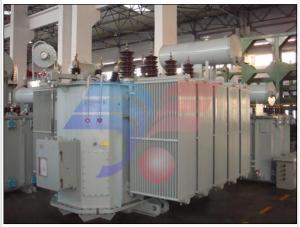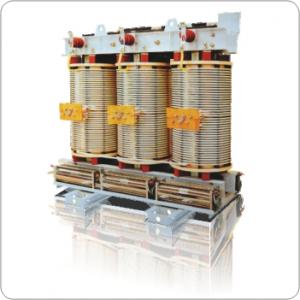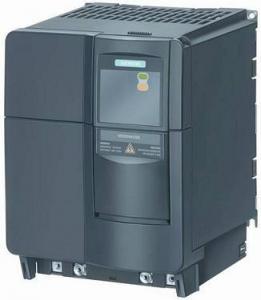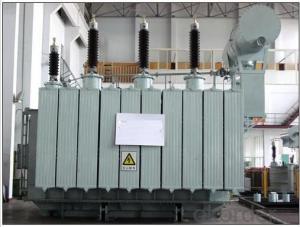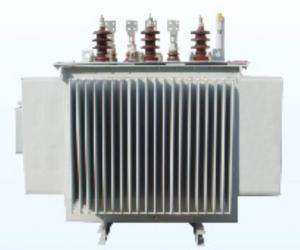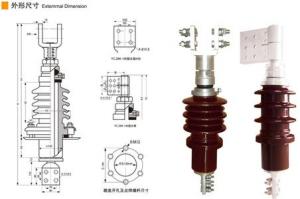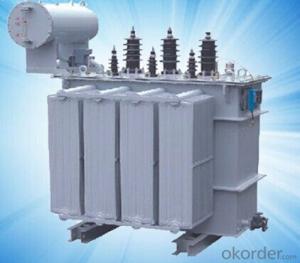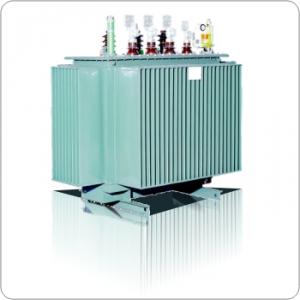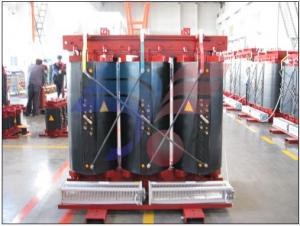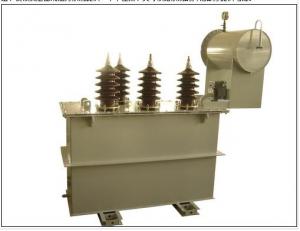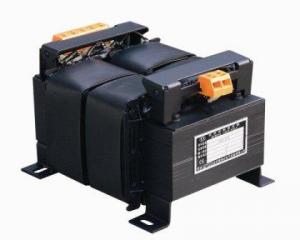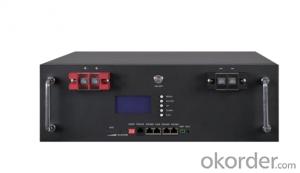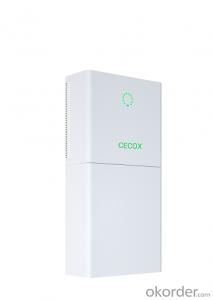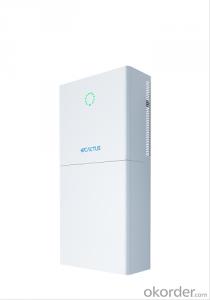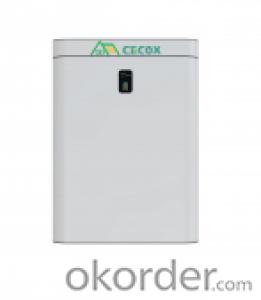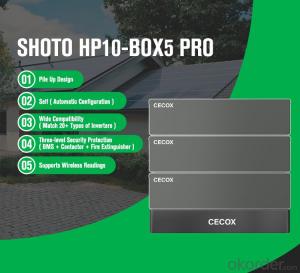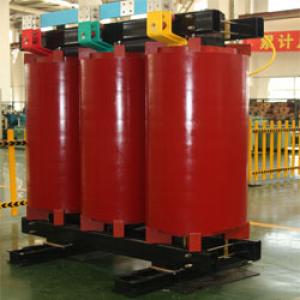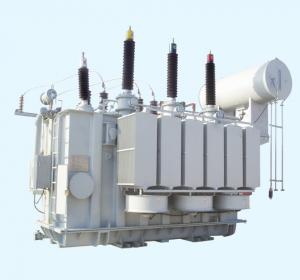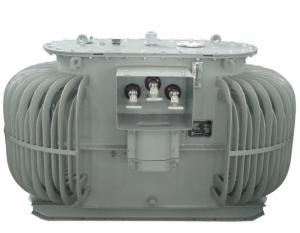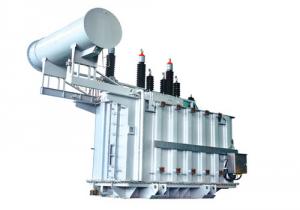Oil-immersed power transformer of 35kV
- Loading Port:
- China Main Port
- Payment Terms:
- TT OR LC
- Min Order Qty:
- -
- Supply Capability:
- -
OKorder Service Pledge
OKorder Financial Service
You Might Also Like
Oil-immersed power transformer of 35kV
1. Product
S9 series power transformer of 35kV is mainly used for the transmission and distribution in the power system of voltage level 35kV and rated frequency 50-60Hz, the capacity of it is 50-31500kVA. The iron core adopts silicon steel sheet with high permeability, full-oblique joints, no punching, and colligated and taken up with semi-dry epoxy fiberglass banding. The fuel tank has three types of radiators: flat tube type, corrugated type and chip type. The 800kVA above transformers are equipped with gas relay, pressure relief valve, oil tank with diaphragm and remote thermometer components.
The transformers of 3150kVA and above are equipped with oil refiner. The characteristics of products are low loss, low noise, save power and so on.
SZ9 series on-load-tap-changing power transformer of 35kV is equipped with tap changer, the voltage regulating range of it is ± 3 × 2.5%. The voltage adjustment can be controlled by manual or automatic through control box. The structures,performances and characteristics of the transformer are as the same as the power transformer of S9 series for 35kV.
The products conform with the GB/T6451-2008 standards.
2. Technical parameter
35kV S9 series distribution transformer technical parameter
Model | Rated Capacity (kVA) | Rated voltage (kV) | Loss (W) | Impedance of short-circuit(%) | No-load current(%) | Label number of connecting group | Weight (kg) | Outside DimensionL x W x H(mm) | Gauge (mm) | ||||
HV | LV | No-load | load | Body | Oil | Ttotal weight | |||||||
S9-50/35 | 50 | 38.5±5% 35±5% | 0.4 | 0.21 | 1.27/1.21 | 6.5 | 2.0 | Yyn0 Dyn11 | 345 | 260 | 820 | 1140×955×1760 | 550/550 |
S9-100/35 | 100 | 0.29 | 2.12/2.02 | 1.8 | 408 | 390 | 1070 | 1180×1070×1910 | 550/550 | ||||
S9-125/35 | 125 | 0.34 | 2.50/2.38 | 1.7 | 415 | 470 | 1100 | 1180×1090×2000 | 550/550 | ||||
S9-160/35 | 160 | 0.35 | 2.97/2.83 | 1.6 | 423 | 555 | 1295 | 1180×1100×2035 | 550/550 | ||||
S9-200/35 | 200 | 0.43 | 3.50/3.33 | 1.5 | 524 | 655 | 1540 | 1260×1150×2075 | 550/550 | ||||
S9-250/35 | 250 | 0.51 | 4.16/3.95 | 1.4 | 550 | 825 | 1755 | 1330×1200×2155 | 660/660 | ||||
S9-315/35 | 315 | 0.61 | 5.01/4.77 | 1.4 | 640 | 945 | 2010 | 1390×1250×2220 | 660/660 | ||||
S9-400/35 | 400 | 0.73 | 6.05/5.76 | 1.3 | 740 | 1125 | 2390 | 1720×1260×2285 | 660/660 | ||||
S9-500/35 | 500 | 0.86 | 7.28/6.93 | 1.2 | 805 | 1289 | 2710 | 2045×1290×2415 | 660/660 | ||||
S9-630/35 | 630 | 1.04 | 8.28 | 1.1 | 885 | 1455 | 3040 | 2155×1320×2250 | 820/820 | ||||
S9-800/35 | 800 | 1.23 | 9.90 | 1.0 | 1050 | 1800 | 3700 | 2265×1340×2700 | 820/820 | ||||
S9-1000/35 | 1000 | 1.44 | 12.15 | 1.0 | 1335 | 2115 | 4510 | 2495×1380×2885 | 820/820 | ||||
S9-1250/35 | 1250 | 1.75 | 14.67 | 0.9 | 1445 | 2610 | 5045 | 2595×1410×2910 | 1070/1070 | ||||
S9-1600/35 | 1600 | 2.12 | 17.55 | 0.8 | 1490 | 2840 | 5740 | 2680×1590×2970 | 1070/1070 | ||||
Note: Load values before “/” are for Dyn11 connection and values after “/” are for Yyn0 connection.
35kV no excitation voltage regulating power transformer technical parameter
Type specification | Rated Capacity kVA | Rated voltage(kV) | Loss (W) | Impedance of short-circuit (%) | No-load current(%) | Label number of connecting group | Weight(kg) | Outside DimensionL x W x H (mm) | Gauge(mm) | ||||
HV | LV | No-load | load | Body | Oil | Total weight | |||||||
S9-800/35 | 800 | 38.5±5% 35±5% | 3.5 6.3 10.5 | 1.23 | 9.9 | 6.5 | 1.0 | Yd11 Ynd11 | 1150 | 1800 | 3900 | 2265×1340×2700 | 820/820 |
S9-1000/35 | 1000 | 1.44 | 12.15 | 0.9 | 1335 | 2115 | 4510 | 2495×1380×2885 | 820/820 | ||||
S9-1250/35 | 1250 | 1.76 | 14.67 | 0.8 | 1445 | 2610 | 5045 | 2595×1410×2910 | 1070/1070 | ||||
S9-1600/35 | 1600 | 2.12 | 17.55 | 0.7 | 1490 | 2840 | 5740 | 2680×1590×2970 | 1070/1070 | ||||
S9-2000/35 | 2000 | 2.72 | 19.35 | 0.6 | 1574 | 3280 | 6410 | 2690×1620×3100 | 1070/1070 | ||||
S9-2500/35 | 2500 | 3.20 | 20.70 | 0.56 | 1885 | 3860 | 7695 | 2730×1900×3000 | 1070/1070 | ||||
S9-3150/35 | 3150 | 3.80 | 24.30 | 0.56 | 2145 | 4610 | 8980 | 2660×2900×3100 | 1070/1070 | ||||
S9-4000/35 | 4000 | 4.52 | 28.80 | 0.48 | 2270 | 5330 | 10060 | 2800×2865×3365 |
| ||||
S9-5000/35 | 5000 | 5.40 | 33.03 | 0.48 | 2580 | 6330 | 11670 | 3460×2940×3430 | |||||
S9-6300/35 | 6300 | 6.56 | 36.90 | 0.42 | 2840 | 7440 | 13430 | 3800×2770×3355 | |||||
S9-8000/35 | 8000 | 9.00 | 40.50 | 0.42 | 3500 | 9650 | 17200 | 4400×3000×3520 | |||||
S9-10000/35 | 10000 | 10.88 | 47.70 | 0.40 | 4400 | 12200 | 21000 | 3800×3550×3750 | |||||
S9-12500/35 | 12500 | 12.60 | 56.70 | 0.40 | 5000 | 13740 | 24500 | 4500×5650×3900 | |||||
S9-16000/35 | 16000 | 15.20 | 69.30 | 0.40 | 5520 | 16800 | 27800 | 4800×3700×4050 | |||||
S9-20000/35 | 20000 | 18.00 | 83.70 | 0.32 | 5900 | 19020 | 31100 | 5240×3830×4040 | |||||
S9-25000/35 | 25000 | 21.38 | 99.00 | 0.32 | 7200 | 23400 | 37600 | 5520×3800×4460 | |||||
S9-31500/35 | 31500 | 25.28 | 118.80 | 1.0 | 7660 | 26080 | 42200 | 5660×3800×4590 | |||||
35kV 2000~12500kVA load voltage regulating power transformer technical parameter
type Specification | Rated Capacity(kVA) | Rated voltage (kV) | Loss (kW) | Impedance of short-circuit(%) | Label number of connecting group | Weight(kg) | No-load current (A) | |||
No-load | Load | Body | Oil | Total weight | ||||||
SZ9-2000/35 | 2000 | 35 | 2.88 | 20.25 | 6.5 | Yd11 | 2.9 | 20.25 | 0.9 | 0.80 |
SZ9-2500/35 | 2500 | 3.40 | 21.73 | 3.44 | 21.74 | 0.9 | 0.80 | |||
SZ9-3150/35 | 3150 | 38.5 35 | 4.04 | 26.01 | 7.0 | 4.09 | 26.0 | 0.81 | 0.72 | |
SZ9-4000/35 | 4000 | 4.84 | 30.69 | 4.95 | 30.7 | 0.81 | 0.72 | |||
SZ9-5000/35 | 5000 | 5.80 | 36.00 | 5.85 | 36.0 | 0.77 | 0.68 | |||
SZ9-6300/35 | 6300 | 7.04 | 38.70 | YNd11 | 7.02 | 38.7 | 0.77 | 0.68 | ||
SZ9-8000/35 | 8000 | 9.84 | 42.75 | 7.5 | 10.0 | 42.7 | 0.68 | 0.60 | ||
SZ9-10000/35 | 10000 | 11.60 | 50.58 | 11.7 | 50.6 | 0.68 | 0.56 | |||
SZ9-12500/35 | 12500 | 13.68 | 59.85 | 8.0 | 13.77 | 59.85 | 0.63 | 0.54 | ||
- Q:How do transformers work detailed descriptions please. Also how are the voltages stepped up or down?
- A transformer is a device that can be used to increase voltage and decrease current (or vice versa). It uses AC power and is based on Faraday's law of induction (mutual induction). A transformer is made up of two coils, each with a different number of turns, linked magnetically through a soft iron core. The magnetic flux from one coil links the other through the core. When the flux in one coil changes, the flux passing through the other will change, inducing a voltage (emf) in the second coil. The coil connected to the AC power source is known as the primary coil (number of turns Np), while the coil in which voltage is induced is known as the secondary coil (number of turns Ns). If the primary coil sets up a changing flux, the voltage in the secondary coil depends on the number of turns in the secondary. The transformer is assumed to be ideal in which the resistance of the coils is negligible and all the flux in the core links both primary and secondary windings. There will be no energy loss in an ideal transformer.
- Q:Current and Potential transformers both are actually Instrument transformers, which step down or lower down the values of current and voltages for measuring purposes.But I have heard of that both CT and PT specifically are used for stepping up current and voltages at some point of transmission system.if this is correct then can anyone tell where they are used?If not then there are step up transformers for similar uses but my question is why they are not called as CT's or PT's.
- Transformers that are called current transformers and potential transformers are designed specifically for instrumentation purposes. They are designed to provide reduced current or voltage signals that very accurately represent the primary current or voltage. They are designed to have a minimal effect on the primary circuit. The are manufactured only in sizes needed for instrumentation purposes. Instrumentation purposes include not only providing signals to meters but providing signals to protective relays and control systems. CTs and PTs may occasionally be used for purposes other than the purposes for which they are designed. I have heard of a CT being used backwards to supply a high current at a very low voltage for some testing purpose. This sort of thing is sometimes done as a temporary measure when more appropriate devices are not available.
- Q:Transformers of the three transformations are the three?
- Take a 10kV / 0.4kV, d / yn11, 100kVA transformer rated voltage full load operation: 1, the high side of the 10kV into the low side of the 400V; 2, the high pressure of 5.77A into low pressure side of 144.4A;
- Q:I am a transformer factory salesman, the company let go to the field to run business, if you go to a strange city, where the main starting from where the few places, and which units to contact? If the local sales in the transformer factory, then work well to carry out? What are the sales channels?
- 1. Power supply company tender 2. Cabinet manufacturers 3, the installation company 4, direct customers, to the planning bureau to find, in advance to know which new project 5, design institute, know some late 6. Power supply company front desk, people come to install more late
- Q:I know that if I needed 600 watts at 120 volts that I would need at least 5 amps, but does the step down create a difference in amperage when using a transformer converting the 120v. to 12v?
- This Site Might Help You. RE: If I have a 600 watt 12 volt transformer plugged into a 120 volt circuit, what 120v. amperage is needed? I know that if I needed 600 watts at 120 volts that I would need at least 5 amps, but does the step down create a difference in amperage when using a transformer converting the 120v. to 12v?
- Q:Before engaging any technician i want to gather some knowledge about planer transformer. It will be good if u have any suggestions.
- In the planar transformers, the winding is done on flat conductive guide line of printed-circuit board printed circuit board or directly the copper mooring. Flat geometry reduce loss of skin effect when switching frequency is high, that is the eddy current loss. Therefore, effectively use the surface conductivity of copper conductor, much higher efficiency than conventional transformers. A profile map of flat transformer, and make use of the different distance between two windings, to obtained leakage inductance and impedance values under the different gap 5vdc 1a adapter.
- Q:I have an AC to DC transformer I got out of a radio. I removed the rectifing (spelling?) circuit. So why is it that the transformer still only responds to AC input and not DC? I basically want a transformer that can take low voltage (aroung 6-12v DC) and step it up to 400VDC. Any suggestions or help?
- You cannot use a transformer to change DC voltage. Transformers work because the expanding and collapsing magnetic field in one coil generate current in the second coil. DC steady voltage current creates a stable magnetic field and so does not generate current in an intersecting conductor. To step up (or down) DC voltage, you have to convert it to AC (old vacuum tube car radios used a multivibrator to create an AC using DC voltage) run it through a transformer to change the voltage and then recify it to get back to DC voltage.
- Q:I want to run a electric motor at 6v from a wall outlet. I need to know what wall plug transformer rating I should use to run it. Here is what I have.
- Better stay away from your USB with motors of any sort. The on/off spike could take something out in the computer. If you care about the Router, try not to go much higher than 20 % above rated voltage. The current draw from a motor increases drastically as you double the voltage applied. Simple adapters have only a transformer, some diodes and maybe a capacitor. When trying a higher voltage, try to get a meter in the line to measure the current. If you exceed to rating for the adapter, expect smoke. Try adding a capacitor (say 1000 microfarad rated for 20 volts) [watch the polarity] to the leads coming out of your adaptor. Better quality direct current will make your motor run better. Simple adapters can be voltage controlled by the variable speed controls available for ceiling fans. Some can be controlled by regular light dimmers. Cheap adapters may be available from Radio Shack as returns where someone mashed the jack.
- Q:Halo4 - love the series, Halo 3 is my favorite, hated Reach. not sure if Halo 4 is more like halo3 or more like reach, will not buy if abilities are includedBlack Ops 2 - BLOPS was my favorite shooter, I will probably get this unless they lower the health to MW2/MW3 standards and they don't fix SMGsTransformers FOC - War for Cybertron was one of the best games I've ever played, but they made Dark of the Moon which was a really bad shooter, and I'm not sure if FOC will be bad as wellWhat would you suggest?
- I would say BLOPS 2 because I have not played any of the other games prequels. That is because I play on ps3 so I am unable to play Halo and Transformers never interested me. Plus I know if there is an error in BLOPS 2 Treyarch will fix it to the best of their abilities unlike IW's take on development which is we have your money already so we don't care.
- Q:I I am looking to buy a 208 to 480 transformer, would I simply buy a 480 to 208 and reverse the input and outputs? it's a 3 phase system and it is being supplied by an 80kW generator, then straight to an ATS to switch power from normal to emergency.
- Yes, a transformer can be used to either step up or step down the voltage. The rating of a transformer is in KVA, so you can load it to the nameplate rating either way. One thing to consider though is your system ground. When you tie your generator feed back through your step up transformer and then to the ATS . The normal power source feeding your ATS is probably a 3 phase 4 wire grounded WYE system, and your step up transformer will probably have a 3 wire Delta primary. You need to be careful, especially if your ATS feeds any single phase loads. In that case, get a transformer with a WYE - WYE winding configuration. Make sure you follow the NEC code recommendations for a separately derived source.
1. Manufacturer Overview |
|
|---|---|
| Location | |
| Year Established | |
| Annual Output Value | |
| Main Markets | |
| Company Certifications | |
2. Manufacturer Certificates |
|
|---|---|
| a) Certification Name | |
| Range | |
| Reference | |
| Validity Period | |
3. Manufacturer Capability |
|
|---|---|
| a)Trade Capacity | |
| Nearest Port | |
| Export Percentage | |
| No.of Employees in Trade Department | |
| Language Spoken: | |
| b)Factory Information | |
| Factory Size: | |
| No. of Production Lines | |
| Contract Manufacturing | |
| Product Price Range | |
Send your message to us
Oil-immersed power transformer of 35kV
- Loading Port:
- China Main Port
- Payment Terms:
- TT OR LC
- Min Order Qty:
- -
- Supply Capability:
- -
OKorder Service Pledge
OKorder Financial Service
Similar products
New products
Hot products
Hot Searches
Related keywords
